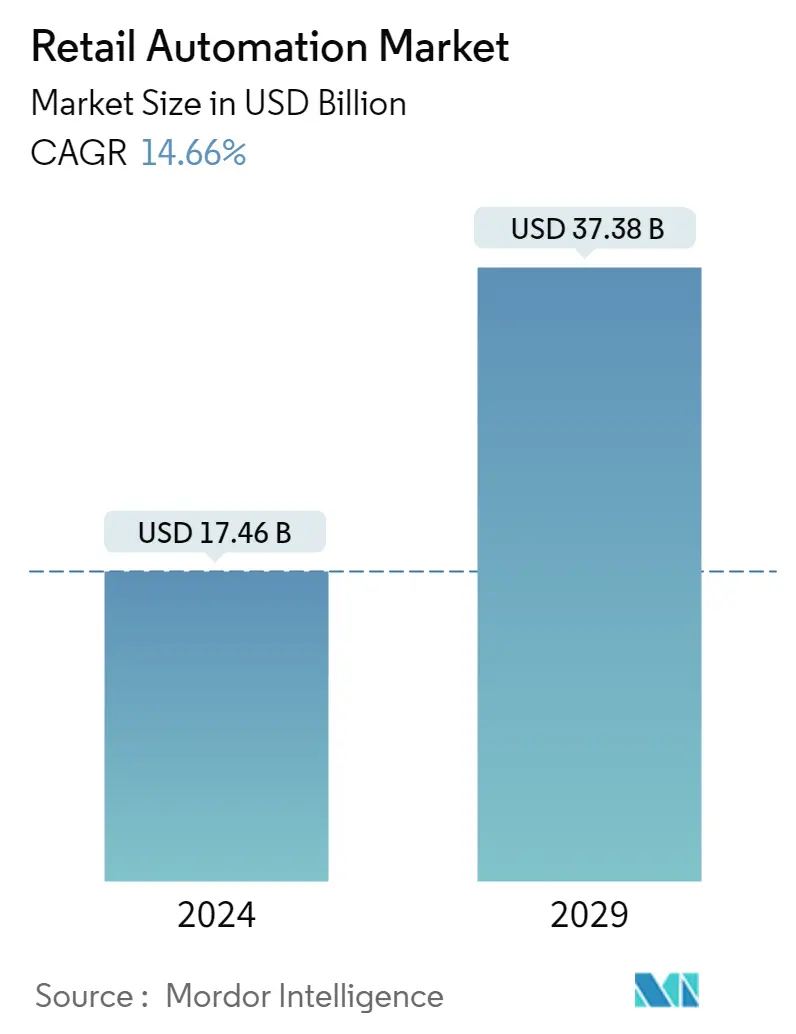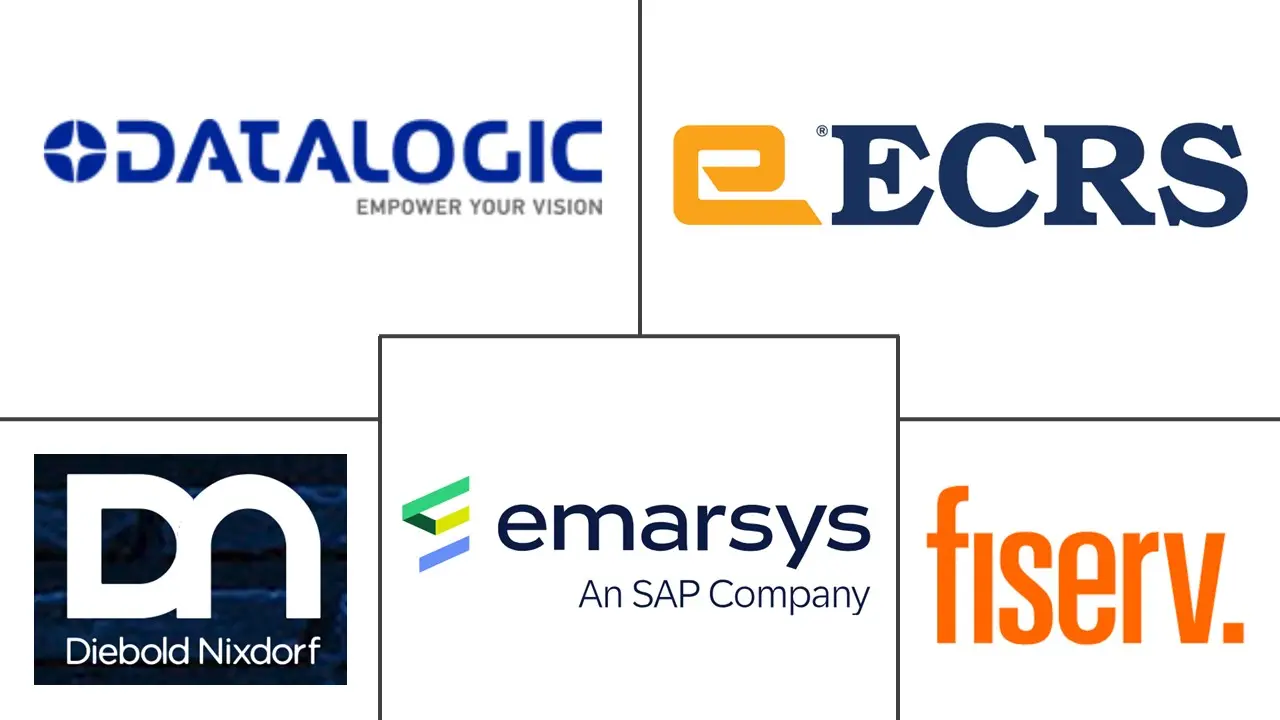Market Size of Retail Automation Industry

| Study Period | 2019 - 2029 |
| Market Size (2024) | USD 17.46 Billion |
| Market Size (2029) | USD 37.38 Billion |
| CAGR (2024 - 2029) | 14.66 % |
| Fastest Growing Market | Asia Pacific |
| Largest Market | North America |
Major Players
*Disclaimer: Major Players sorted in no particular order |
Retail Automation Market Analysis
The Retail Automation Market size is estimated at USD 17.46 billion in 2024, and is expected to reach USD 37.38 billion by 2029, growing at a CAGR of 14.66% during the forecast period (2024-2029).
- Retailers have recently faced challenges as the technological revolution has gained attention and adoption significantly. Such technologies and innovations have been reshaping the behavior of consumers and their way of collaborating and communicating pre - and post-sales. Features, such as convenience and transparency, provided by automation have been pushing retailers to adapt and upgrade their PoS systems. Furthermore, due to their cost-effectiveness, the demand for PoS systems has significantly risen among small retail stores.
- Retail automation assists with handling triggering reactions, interacting with other digital systems, and handling data. Cheaper operational risk, lower costs, a better customer experience, and increased productivity are just a few advantages of using this software.
- The requirement for human intervention can be minimized by using automation technologies to carry out repetitive operations like bookkeeping. The firm operates smoothly, efficiently, and consistently owing to automation, which can determine the shortest and most precise way to do the operation and repeat the process. With retail automation, shoppers may browse products using a touchscreen interface, and transactions take less time. The ability to choose the product of customers choosing and proceed to payment with a credit or debit card is made possible by retail automation.
- The growth further influences the market for machine learning capabilities incorporated into retail automation. Robotic process automation (RPA) uses artificial intelligence (AI) to provide better business insights and data integrity. Additionally, the retail automation market benefits from rising urbanization, a shift in lifestyle, an increase in expenditures, and higher consumer spending.
Retail Automation Industry Segmentation
Retail automation is the usage of Artificial Intelligence and Machine Learning in retail operations. It includes self-service, standalone kiosks that operate as fully automatic retail stores through the use of software integration to replace the traditional retail services in a conventional retail store. These standalone kiosks are located in various crowded locations such as airports, malls, resorts, and transit hubs. They make transactions take place faster and with greater efficiency and also enhance the customer experience. It empowers employees with real-time data and analytics.
The retail automation market is segmented by type (hardware and software), end-user (grocery, general merchandise, and hospitality), and geography (Europe, North America, Latin America, Asia-Pacific, and the Middle East and Africa). The market sizes and forecasts are provided in terms of value (USD) for all the above segments.
| By Type | ||||||
| ||||||
| Software |
| By End-User | |
| Grocery (Supermarkets, Hypermarkets, Convenience Stores (with and without Fuel), and Drugstores) | |
| General Merchandise (Hardgoods, Softgoods, and Mixed General Merchandise, like Departmental Stores, etc.) | |
| Hospitality (Hotels (including Casinos, Resorts, Cruise Ships, etc.) and Restaurants) |
| By Geography*** | |||||
| |||||
| |||||
| |||||
| Australia and New Zealand | |||||
| Latin America | |||||
| Middle East and Africa |
Retail Automation Market Size Summary
The retail automation market is experiencing significant growth, driven by the increasing adoption of advanced technologies such as artificial intelligence, robotics, and cloud solutions. These innovations are reshaping consumer interactions and enhancing operational efficiencies by minimizing the need for human intervention in repetitive tasks. Retailers are upgrading their point-of-sale systems to offer greater convenience and transparency, which are becoming essential in meeting evolving consumer expectations. The market is characterized by a fragmented landscape with numerous solution providers, all vying to leverage the latest technological advancements to gain a competitive edge. Strategic developments, including investments and partnerships, are further propelling market expansion, as companies seek to enhance their capabilities and explore new market opportunities.
North America stands out as a leading region in the retail automation market, with major players like Walmart and Amazon driving the adoption of automation technologies. The region's experimental retail environment and high demand for cloud solutions, particularly in specialty stores, contribute to its market dominance. The integration of cloud-based services, such as Software as a Service (SaaS), is expected to play a crucial role in enhancing customer-facing functionalities. The market's growth is also supported by strategic partnerships and technological integrations, such as those between UST and SAP, which aim to streamline operations and improve data analytics capabilities. As the market continues to evolve, companies are focusing on research and development to maintain their market share and explore expansion strategies.
Retail Automation Market Size - Table of Contents
-
1. MARKET INSIGHTS
-
1.1 Market Overview
-
1.2 Industry Value Chain Analysis
-
1.3 Industry Attractiveness - Porter's Five Forces Analysis
-
1.3.1 Bargaining Power of Suppliers
-
1.3.2 Bargaining Power of Buyers
-
1.3.3 Threat of New Entrants
-
1.3.4 Threat of Substitute Products
-
1.3.5 Intensity of Competitive Rivalry
-
-
-
2. MARKET SEGMENTATION
-
2.1 By Type
-
2.1.1 Hardware
-
2.1.1.1 POS System
-
2.1.1.2 Self -checkout System
-
2.1.1.3 RFID and Barcode Scanners
-
2.1.1.4 Other Hardware Types
-
-
2.1.2 Software
-
-
2.2 By End-User
-
2.2.1 Grocery (Supermarkets, Hypermarkets, Convenience Stores (with and without Fuel), and Drugstores)
-
2.2.2 General Merchandise (Hardgoods, Softgoods, and Mixed General Merchandise, like Departmental Stores, etc.)
-
2.2.3 Hospitality (Hotels (including Casinos, Resorts, Cruise Ships, etc.) and Restaurants)
-
-
2.3 By Geography***
-
2.3.1 North America
-
2.3.1.1 United States
-
2.3.1.2 Canada
-
-
2.3.2 Europe
-
2.3.2.1 United Kingdom
-
2.3.2.2 Germany
-
2.3.2.3 France
-
-
2.3.3 Asia
-
2.3.3.1 China
-
2.3.3.2 Japan
-
2.3.3.3 India
-
-
2.3.4 Australia and New Zealand
-
2.3.5 Latin America
-
2.3.6 Middle East and Africa
-
-
Retail Automation Market Size FAQs
How big is the Retail Automation Market?
The Retail Automation Market size is expected to reach USD 17.46 billion in 2024 and grow at a CAGR of 14.66% to reach USD 37.38 billion by 2029.
What is the current Retail Automation Market size?
In 2024, the Retail Automation Market size is expected to reach USD 17.46 billion.

